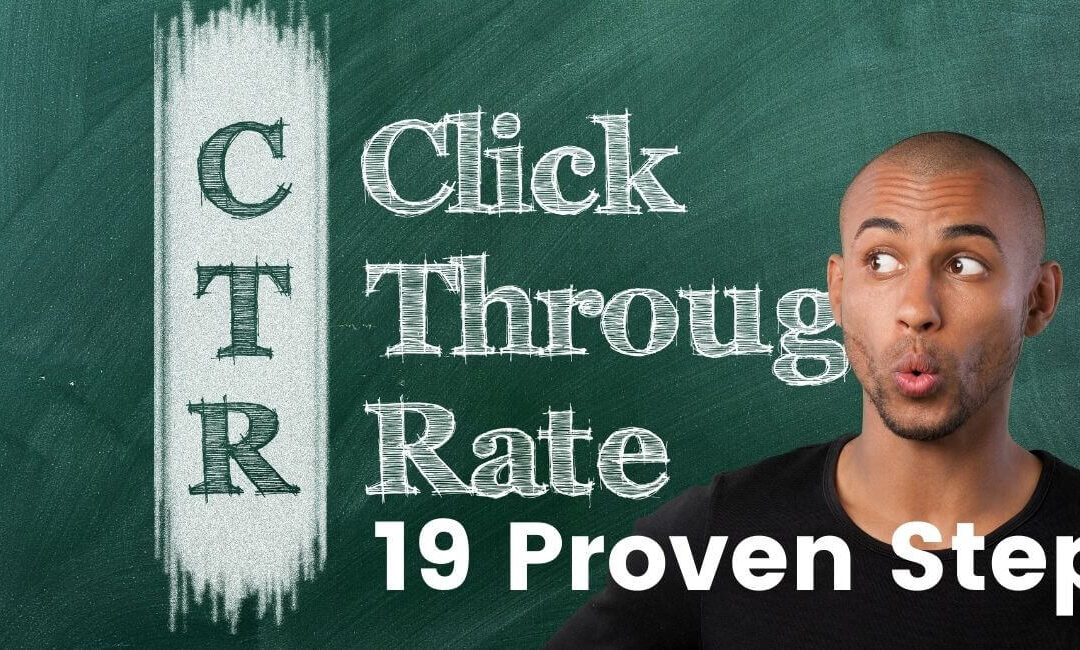Steps to Boost Your Organic CTR in Google
Are you frustrated with your organic CTR in Google? You’re not alone. In fact, we’ve seen a lot of people who are struggling to get their content found on the first page of search engine results pages (SERPs). It’s time to take action and start implementing these best practices that will help you boost your organic CTR in Google. Improve ctr in google search is a tricky system and it take time to understand.
We’ll show you how to do this by providing tips for writing headlines, creating content, and optimizing images. These three steps will help increase your CTR and rank higher on SERPs so more people can find what they need from your website!
What Is Organic CTR?
Conversion rates are a key metric for marketers, which is why it’s important to know what organic CTRs are and how they impact marketing campaigns. Organic CTRs refer to the number of clicks on an ad that comes from organically generated traffic. It is calculated as follows:
“Organic CTR = (number of organic clicks)/(total number of organic and paid clicks)” “This metric can be used to estimate how much your campaign has benefited from social sharing.”
Does Organic CTR matter?
What does it mean for your SEO and Website ranking? Is there a correlation between organic clicks and rankings? The answer is yes. This article will explore what Organic Clicks are, how they can correlate to website ranks, and the best practices to ensure you’re getting them in order to succeed at SEO.
What is a good CTR for Google search?
Your Google search results may have an average CTR of anywhere from 3% to 30%. The higher your position, the more people are likely to see what you’re offering. Not only can a high-ranking increase be achieved by improving their ranking on Google but also optimizing your title, URL, and meta description for increased visibility in searches.
You could improve your chances at receiving clicks with just minor changes like better optimization or adjusting rankings – all it takes is making some simple adjustments!
How Can The Organic CTR Be Improved?
Follow these 19 steps today to improve your SEO strategy:
1. Identify Your Lowest Organic CTR Content
To get started, you need to identify what content is receiving the least amount of organic clicks. To do this, you’ll want to take a look at which pages are receiving exactly zero organic CTR.
Steps:
1. Log in to Google Analytics and click on “Acquisition”.
2. Click on ‘Search Traffic’. Then, select ‘Organic Search’ from the drop-down menu and click on “Top Content”.
3. Sort by descending order of a number of organic clicks (default) or views for a specific time period.
4. Filter for zero organic clicks, which will give you a list of pages with no organic traffic.
You can run this report for as long as you’d like to see what content gets more or less natural search traffic over the course of your marketing campaign (i.e., three months).
Now try to improve the content and Put more attractive titles so that people click your result.
2. Fix Any Keyword Cannibalization Problems
Are you finding that there are certain terms being used in your site’s content that do not get any organic CTR? Look to see if these terms are cannibalizing the rest of your keywords. Step one is to make sure each page on your website has a unique title. This will help maintain separate search rankings for each page so it can be found by multiple search terms.
Steps:
1. In Google Analytics, go to the Behavior>Site Content section and click on “All Pages”.
2. Sort this page for traffic from organic searches for a given period of time (i.e., six months). Identify where there are duplicated titles within your content.
3. Use Long-tail Keywords in Your Titles
Long-tail keywords are specific phrases that people might use when searching for information. They tend to be less competitive on search engines and provide a better chance at ranking higher in organic results. According to Neil Patel, “For every single keyword you rank for, Google is going to give you about 30% of the click-throughs.”
Tip: Start off with the keyword you already have in your title. Measure how many organic clicks and views that page has received within a specific period of time (i.e., six months). Then, find long-tail terms that relate to your content and add them in your post and if possible in your title.
4. Write Effective Meta Descriptions
Meta description tags are used to give potential visitors a quick overview of your site. The meta description provides the search engine with an idea of what you’re about and then links to your page.
Using effective meta descriptions not only improves SEO rankings but also gives away a better user experience.
With 160 characters your meta description should be best at communicating what the website is about and including keywords.
5. Get Creative With Your Titles
Analyzing how a reader will actually come across your text is very important. Whenever people look for terms associated with your business, what words are people going to use?
For example, if you run a bakery, people could be looking for cakes, wedding cakes, or cake-making supplies – they are all terms that your customers may use and it’s up to you to incorporate them in your title so they click through to your site.
Tip: Adding the word “how” helps people understand how to find what they’re looking for. Adding a number (i.e., “top five”, “ultimate”) also helps in capturing your audience’s attention because it draws them in by making it sound like you have what they are searching for on the page.
6. Avoid Heavy Title Tags
These are not only boring, but search engine bots have also recognized that the title of your article wasn’t written to please readers. It was made to attract people into clicking and browsing only.
7. Utilize Brackets in Your Titles
Brackets have been known to increase click-through rates from organic search engines. By adding brackets around a keyword, you are telling the engine that your intended words are one unit and should be searched as such in results. A study by HubSpot found that headlines with brackets increased clicks by 40%.
8. Try a Numbered List
Numbered lists are popular among readers. They allow them to skim through the article, giving you a good indication of how much they actually want to read your content – which can be helpful in determining future writing strategies.
We included this number for a reason. Research by Conductor found that numbers increase the chances of succeeding with content marketing by up to 36%.
9. Utilize the Current Calendar Year
Reading dates can be confusing for readers and if they come across an old date, they may not click. Having a current year tag on your article lets them know that it is up-to-date and current whenever you write new content for the site.
In his guest article for David Siteman Garland’s Traffic Analytics blog, Brian Dean detailed the lead-up to and results of a 7-day experiment where he increased his organic traffic by 652%.
10. Use Descriptive URLs
URLs are the website addresses used to direct people to your content. Using descriptive URLs means that search engines can better understand and index your page as well as give an easy overview for users to remember and recognize a link through. For example, both of the following does exactly the same thing.
11. Utilize Structured Markup
This is a type of HTML that gives users and search engines information about your site’s content. It helps to organize your website and allows you to add more elements to the page such as products, project diary posts, and videos.
Common schema types include:
- Organization.
- Person.
- Local Business.
- Product & Offer.
- Breadcrumbs.
- Article.
- Video.
- Event.
- FAQ.
12. Use Emotional Word in Title Tags
In his guest article for David Siteman Garland’s Traffic Analytics blog, Michael Brenner explained how using words with positive connotations can increase your CTR by 66.6% and clicks from search engines by 35%. These emotional connections also help to build a stronger relationship with readers, which in turn leads to more traffic and shares.
To capture people’s attention, you should incorporate emotion.
Don’t be a clickbait article, but don’t be scared to use words like “proven”, “instant”, and so on.
13. Use Positive or Negative Sentiment in Your Title
The words you use can affect the way people feel towards your brand and consequently what they do with that feeling.
A study by marketers at the University of California, Berkeley found that negative sentiment in articles could make people more likely to purchase a product or service from a company than if the same article was presented positively.
Furthermore, one study from the Iowa State University of Science and Technology showed that positive words have a greater impact on consumers with negative word associations.
For example, in his guest post for David Siteman Garland’s Traffic Analytics blog, Yanik Silver mentioned how he increased his click-through rate by 67% by using positive words in his titles.
14. Use Title Case
Title case is essential for drawing the attention of readers and search engines. By keeping the first letter intact in all words except articles and prepositions, your article stands a better chance of being noticed by relevant people and search engines alike.
The use of title cases often results in higher click rates because it makes the headline stand out.
15. Structure Content for Featured Snippets
Featured Snippets are the snippets you see above a Google search result and they allow for users to get answers without having to leave your site. If you want your information to appear here, make sure that it fits the requirements of this structured content by using header tags and shorter paragraphs in order to fit into the appropriate number of characters per line.
A study by HubSpot found that the CTR for high-volume keywords increased by 114% when they appeared as featured snippets in their search results.
When researching the Google SERPs for a given keyword, keep an eye open for listings as”featured snippet.”
If so, it’s important that you structure your content like the featured snippet is displaying its answer.
16. Improve Page Load Time
Google has created an index time estimate. It uses data from real user behavior to see how long users are waiting for a website to load, then converts that information into an estimated number of searches affected by the site’s slow loading. If this number is higher than 3 sec, your rankings may be impacted. Use cache plugins like WpRocket to make your site fast for core web vital.
17. Test headlines on social media
Using Facebook, Twitter, Pinterest, and more to test a headline on real people can be potentially valuable.
When you’re creating an ad or writing a blog post, putting your content in front of potential customers could provide valuable insight into what resonates with that audience.
18. Use Rankmath Plugin to improve your title and meta description
In order to increase your click-through rate, it is important to use descriptive information for both of these areas. The RankMath plugin can help you with this by providing an easy-to-use interface and give suggestions based on the current page. Using this plugin will save you time and help improve your ranking with a more effective title and meta description.
19. How Does Google Prevent Click Fraud?
Google uses an automated system to detect “click spam” and “search term scams.” When it detects possible click fraud, the search engine will send suspicious traffic back to your site to confirm whether or not this is a case of fraudulent behavior. If Google suspects that you are engaging in click fraud, they will penalize your site.



Recent Comments